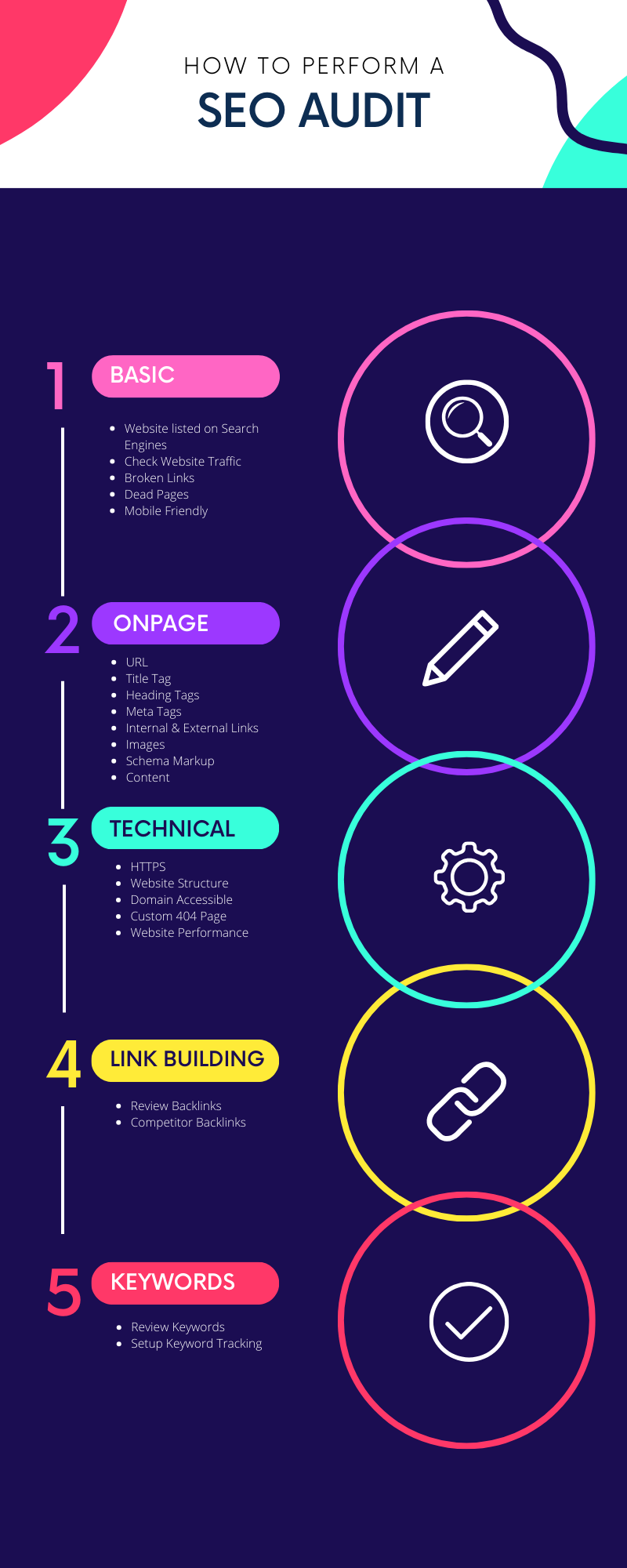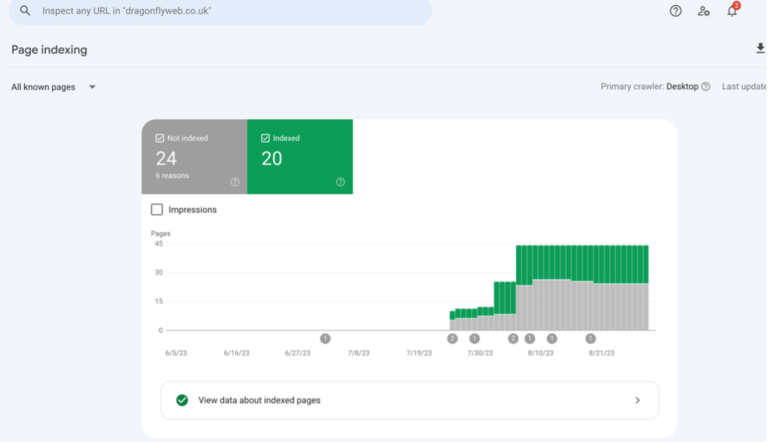
Table of Contents
Introduction
An SEO audit should be the first thing you do when you decide to optimise your website. By performing an SEO audit, you can better understand the work that needs to be done, allowing you to create an action plan.
1. Basic
Website Listed on Search Engine
The very first step is to check which pages on your website that Google knows about. This is a very simple task to carry out:
Go to Google and type in your website address like this site:<yourwebaddress>.com

This will return all the web pages Google is aware of. Check through each result and confirm if the web pages you are aware of are listed.
If, however, you find webpages not listed here, then you may have an indexing problem. Go to your Google Search Console and review if there are any indexing issues.

Some of the common indexing errors are:
• 404
• Soft 404
• Excluded by no index tag
• Duplicate based on canonical
• Blocked by robots.txt
Check out Google’s webpage on how to fix these issues.
You should also submit a sitemap, which allows you to help search engines crawl and index your web pages. To create a sitemap, there any many tools out there to help with this. Once created, submit it on Google Search Console and Bing Webmaster.
Check Website Traffic
From this point, take note of the number of Organic Search. You will want to monitor this closely in the future.
Broken Links
Broken links are detrimental to SEO, as Google considers them a poor user experience.
You’ll need a tool like Screaming Frog to check for broken links. Enter your website domain name in Screaming Frog, then click “Start”. Once complete, go to the URL tab and review any web pages with a status code 404.
If the webpage is not needed, simply delete it. However, if the webpage has many backlinks, you do not want to lose all that link juice. In this case, create a redirect (301) to another functioning webpage.
Dead Pages
Mobile Friendly
2. On-Page
URL
Use clear and concise URLs, as this helps users understand what the page is about. From an SEO perspective, it is also a good idea to include a keyword in your URL.
For existing websites, you should be cautious about changing live URLs as this can negatively impact your SEO health.
Title Tag
The title tag is one of the most crucial aspects of on-page SEO. It represents the highlighted text that appears in search results. Google uses the defined keyword in the title tag for ranking purposes. Therefore, ensure you include the keyword you want to rank for in the title tag.
Include only one keyword and do not repeat the keyword.
You shouldn’t make the title character length excessively long; aim to keep it under 60
Heading Tags
These are the HTML heading tags that appear on the web pages. Ensure that you don’t use the same text for your H1 tag as you do for your title tag.
Include an H1 tag for the web page title and incorporate your keyword. Make sure you only have one H1 tag, as search engines can become confused if there are too many H1 tags. For the rest of the page, use the remaining heading tags.
Additionally, ensure that the heading tags appear in descending order on the rest of the page.
Meta Tags
Links
Images
Consider using image sitemaps to assist search engines in finding and indexing your images.
Schema Mark Up
Schema markup, or structured data markup, consists of pieces of data that you add to your web pages to provide additional information such as services, products, business, etc. This helps search engines better understand the content of your website.
You can create a schema markup manually or use a tool to generate it. Google provides a testing tool so you can see if the structured data markup has been applied correctly.
Content
3. Technical
HTTPS
HTTPS is a security protocol that ensures the security of all transactions between a user and the website. It has become the standard for most websites and is typically in basic domain hosting packages.
Checking for HTTPS on a website is straightforward. When you open a website, you can verify it by looking for the padlock icon in the URL bar.

If you notice anything different, contact your web hosting company.
Website Structure
Having a well-organised website structure is immensely beneficial for SEO. It aids search engines in locating and crawling your website while providing users with easy navigation.
You should aim for a flat-style model that doesn’t extend beyond 3 or 4 layers deep.
Review each layer of the website to determine if any changes can be made. On established websites, making structural adjustments may be more challenging than on new websites.
Domain Accessible
You need to ensure that your website is accessible only on one domain. If users can access your website from multiple locations, it can lead to a number of indexing issues.
Utilise a tool like httpstatus.io, to confirm everything works.

Custom 404 Pages
To enhance your SEO, you want to create a custom 404 page that aligns with your brand. To check if your website has a custom 404 page, type in some random gibberish letters after the domain name e.g., drgonflyweb.com/blahblahblah
Website Performance
Website performance is a critical aspect of SEO. It is crucial to ensure your website is operating at its best. Search engines won’t rank your website highly if it’s slow and has bugs.
Analyse your website using Google’s performance checker tool. This tool provides metrics in several areas but pay special attention to the ‘Performance’ category. Review and address any issues to ensure your website performs well and achieves a green score.

4. Link Building
Review Backlinks
In this process of an SEO audit, you want to assess the backlinks currently pointing to your website. This task is essential for identifying broken backlinks and evaluating whether any backlinks are doing more harm than good.
Competitor Backlinks
Utilise a tool like Semrush to identify your competitor’s backlinks. You want to determine if there are any backlink opportunities you can leverage. This might include identifying broken links to your competitor’s website or finding opportunities to create even better content than your competitors.
After analysing the opportunities, reach out to the domain owners to propose a backlink to your website. It is essential to keep track of these opportunities and your journey.
5. Keywords
Review Keywords
Just as with reviewing backlinks, you should assess which keywords your website is organically ranking for. Take note of any irregularities, such as keywords you were unaware of, pages ranking for unintended keywords, and any missing keywords.
Keyword Tracking
It is a good idea to track keywords going forward and set up automated notifications. For any keywords you want to target, keep a record of their SERP positions and mark them to monitor regular updates. If the keywords are not ranking as expected, you need to review and adjust your methods.
Conclusion
This article should provide you with a solid foundation on how to perform an SEO audit. There are areas where you can delve deeper, but that will depend on the size and complexity of the website.
Dragonfly Web provides a full suite of services along with a free SEO audit. Feel free to get in touch to see how we can assist you.
